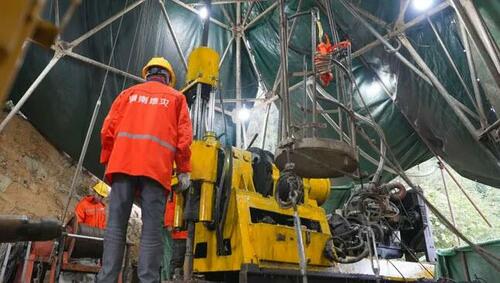Chinese scientists have uncovered a "supergiant" deposit of high-quality gold ore hidden near some of the country's existing gold mines. The vast reserve, which could be the largest single reservoir of the valuable metal left anywhere on Earth, could end up being the largest known deposit of the precious metal anywhere in the world, and is worth more than $80 billion.
As LiveScience reports, the new deposit was uncovered at the Wangu gold field in the northeast of Hunan province, representatives from the Geological Bureau of Hunan Province (GBHP) told Chinese state media on Nov. 20. Workers detected more than 40 gold veins, which contained around 330 tons (300 metric tons) of gold down to a depth of 6,600 feet (2,000 meters). However, using 3D computer models, mining experts have predicted that there could be up to 1,100 tons (1,000 metric tons) of gold — roughly eight times heavier than the Statute of Liberty — hidden at depths of up to 9,800 feet (3,000 m).
If true, the entire deposit is likely worth around 600 billion yuan ($83 billion), GBHP officials said.
 Researchers drilled down around 6,600 feet below the ground and identified more than 40 veins of gold ore.
Researchers drilled down around 6,600 feet below the ground and identified more than 40 veins of gold ore. Officials revealed that the maximum quality of the new deposit was 138 grams of gold per metric ton of ore, which is relatively high compared with most other gold mines around the world. "Many drilled rock cores showed visible gold," Chen Rulin, an ore-prospecting expert with GBHP, told state media.
More gold was also found during test drills around the new site's "peripheral areas," suggesting there are more large deposits waiting to be tapped in the future, experts said.
It is hard to keep track of the amount of gold left in the various mines across the world due to fluctuations in the rate of extraction at each site and a lack of transparency in reporting results. However, as of 2022, the largest known remaining gold reserves on Earth are found in South Africa's South Deep gold mine, which has around 1,025 tons (930 metric tons) of gold, according to Mining Technology. This means the new deposit could be the largest known natural stockpile of gold on the planet.
 Mining experts believe that the new deposit contains up to 1,100 tons of gold
Mining experts believe that the new deposit contains up to 1,100 tons of goldNews of the discovery sent ripples through the mining community and the wider global economy. As LiveScience notes, the price of gold jumped to around $2,700 per ounce - just below a record high set earlier this year - although it is unclear why a surge in gold supply would push the price of gold higher.
China is already the biggest producer of gold in the world, accounting for around 10% of global output in 2023, according to Reuters. However, the country still uses more gold than it can produce, consuming around three times as much of the precious metal as it can dig up. As a result, China relies heavily on importing gold from countries like Australia and South Africa.
 China currently mines around 10% of the world's newly dug up gold every year.
China currently mines around 10% of the world's newly dug up gold every year. The new gold deposit could help alleviate this issue but will not solve the problem completely. Based on current consumption rates, the entire deposit would only supply the country's needs for around 1.4 years.
By the end of 2023, an estimated total of 234,332 tons (212,582 metric tons) of gold have been dug up in human history, with more than two-thirds of this being extracted since 1950, according to the World Gold Council.
This may seem like a lot. But if you were to melt down all the gold ever mined and put it into a single cube, it would only be around 72 feet (22 m) across, according to the World Gold Council, slightly shorter than the length of a blue whale.
Source link

